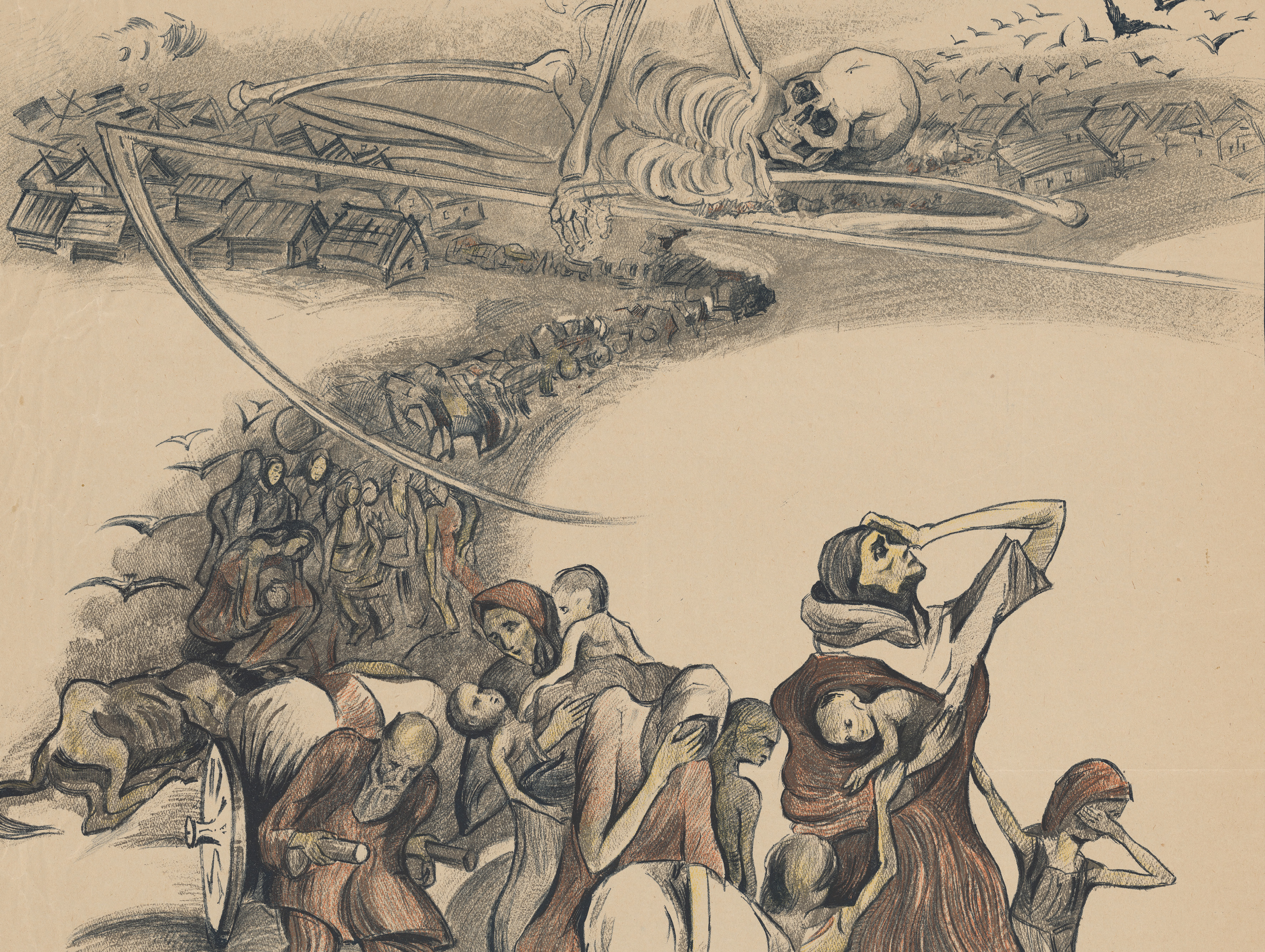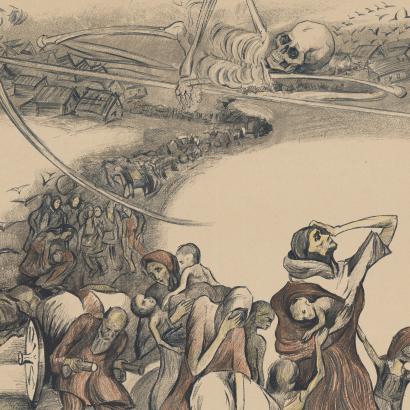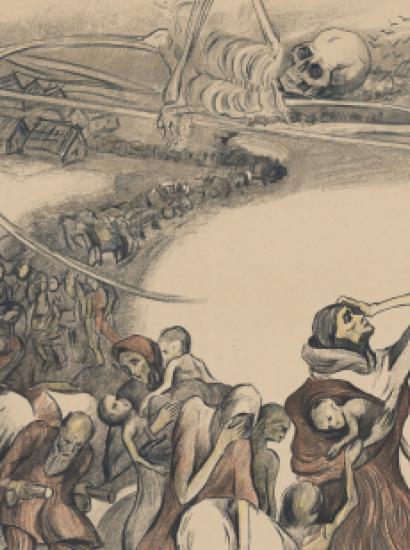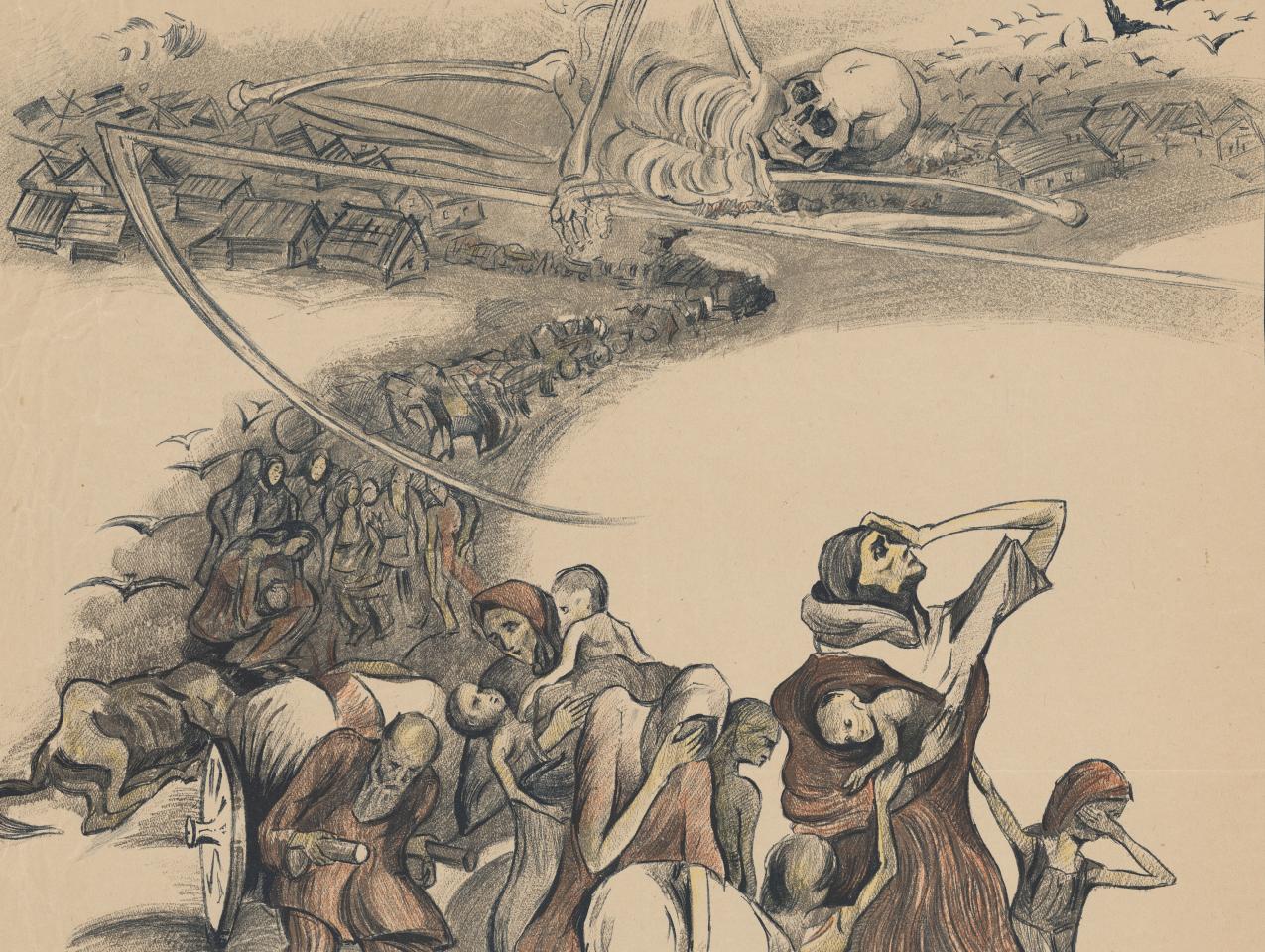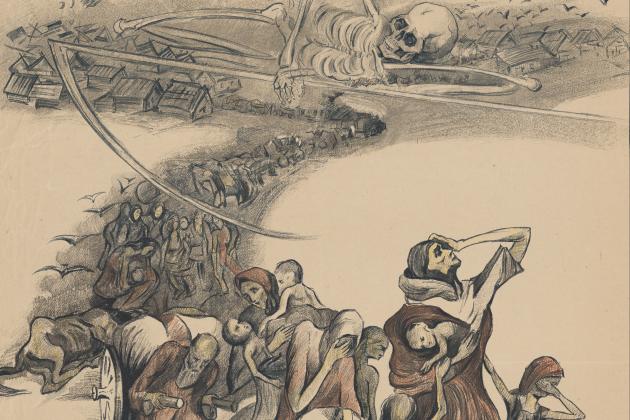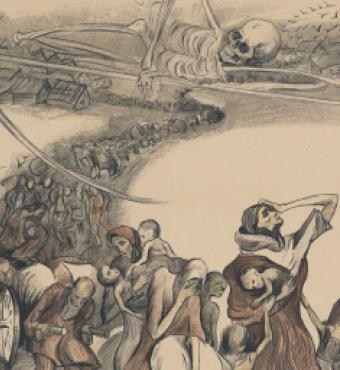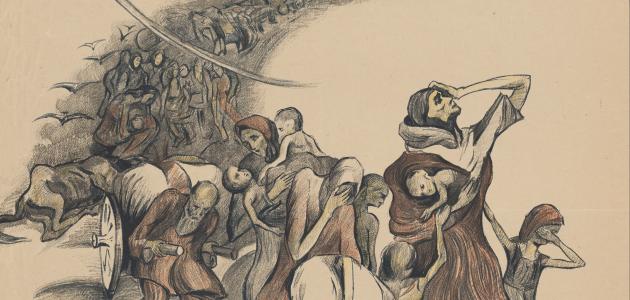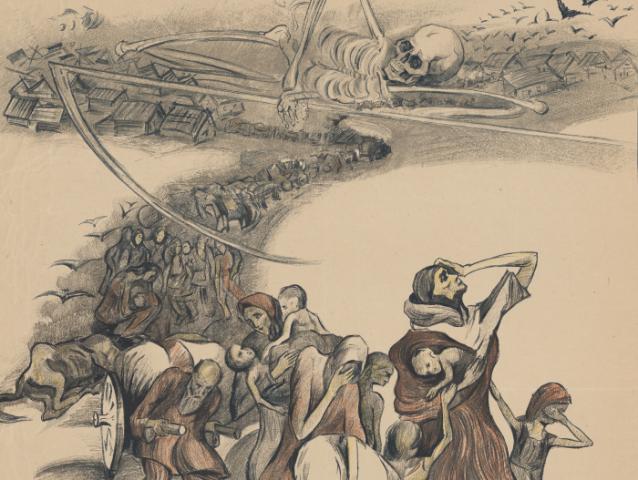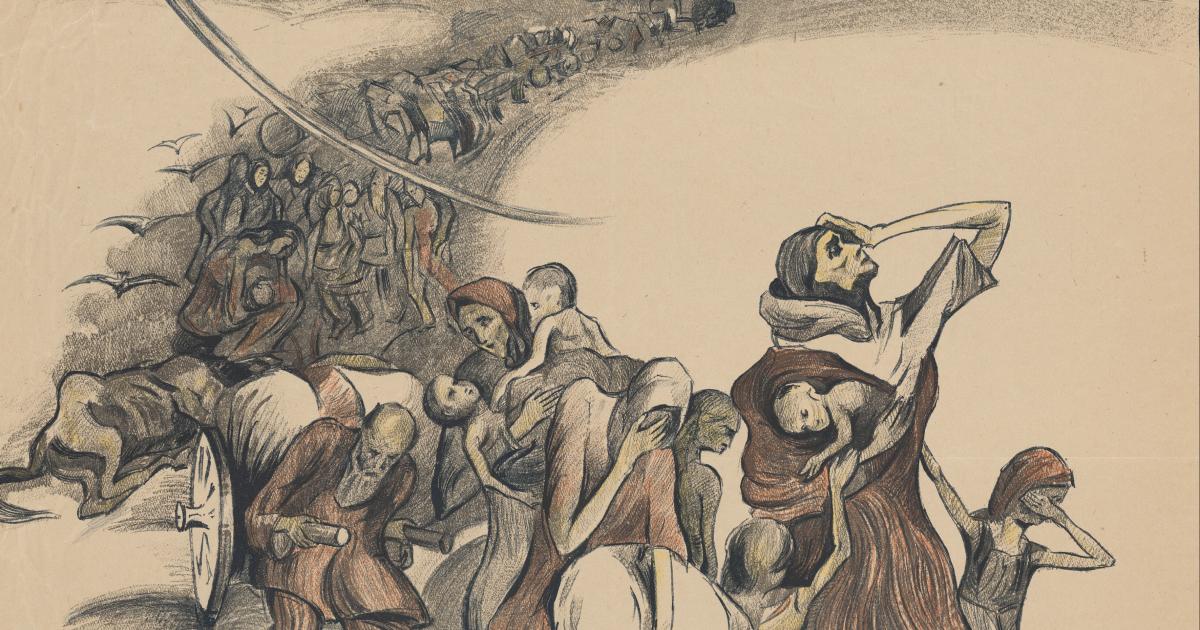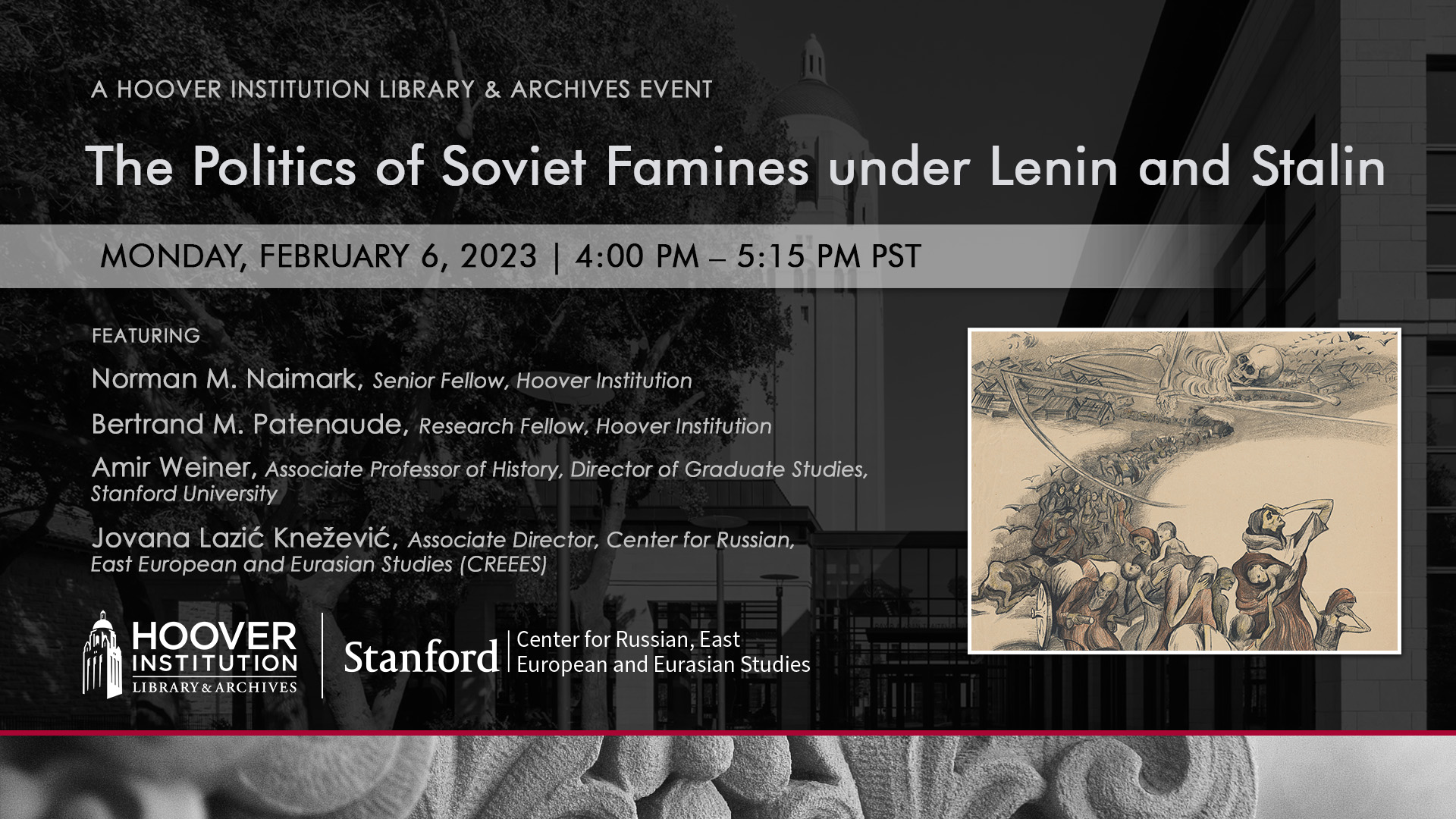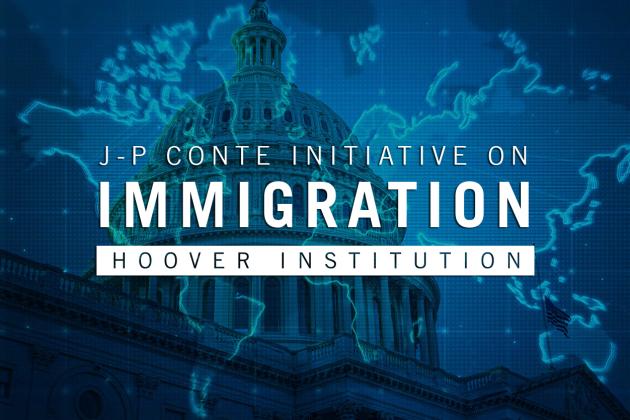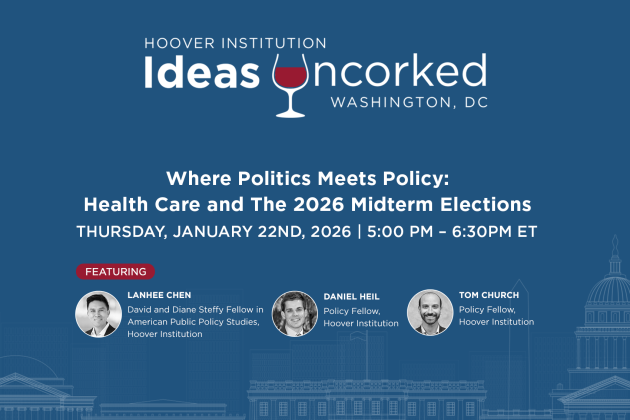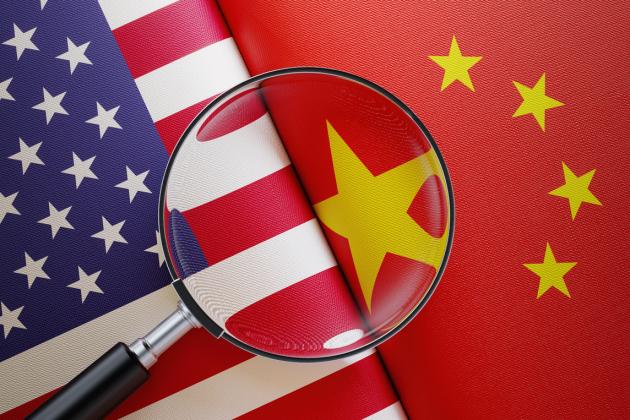

The Hoover Institution Library & Archives presents the Bread + Medicine Speaker Series. This third event is co-sponsored by the Center for Russian, East European and Eurasian Studies (CREEES), Stanford University and is moderated by Jovana Lazić Knežević, Associate Director, CREEES. Speakers will include Norman M. Naimark, Robert and Florence McDonnell Professor of Eastern European Studies, Senior Fellow, Freeman-Spogli Institute, Senior Fellow, Hoover Institution, Stanford University; Bertrand M. Patenaude, Research Fellow, Hoover Institution; and Amir Weiner, Associate Professor of History, Director of Graduate Studies, Stanford University. “America’s Famine Relief Mission in Soviet Russia at 100: Shifting Views from Lenin to Putin” is a hybrid event that will be held on Monday, February 6, 2023, starting at 4:00 pm PT | 7:00 pm ET (75 minutes).
Famine punctuated the first three decades of Soviet history. Disputes over Soviet famines have long been among the major controversies in the historical field. Historians debate the causes of Soviet famines, including to what extent they resulted from or were exacerbated by deliberate government policies, while demographers disagree about their death tolls. Three specialists will discuss similarities and contrasts of the three major Soviet famines: the so-called Volga famine of 1921–22 in the aftermath of the Russian Civil War, the famine of 1932–33 amid the campaign to collectivize agriculture—memorialized by Ukrainians as the Holodomor—and the famine of 1946–47 in the wake of the Second World War.
>> Eric Wakin: Welcome, good afternoon, my name is Eric Waken. I'm the deputy director of the Hoover Institution and the Director of the Library and Archives. It's my great pleasure to welcome you to today's Bread and Medicine speaker series. Today's talk is entitled the politics of soviet famines under Lenin and Stalin.
Welcome to the Hoover Institution. And let me thank the director of the institution, Condi Rice, for her support of the library and archives. For our board of overseers, for their support, and all the donors of the Hoover Institution who support what we do. We are entirely privately funded, and nothing we do would be possible without the support of our donors.
I also want to thank our co sponsor, center for Russian, East European and Eurasian Studies at Stanford University. I always like to just give a couple minutes on Herbert Hoover. We're here because of his vision, who endowed what was then called the Hoover War Library in 1919 with what was then a $50,000 donation, which was quite substantial.
If you do it in today's dollars, you get about $800,000. And his entire donation document was a telegram. The operative words in it were collect material on war, open quote, close quote. And since then, we've grown into a $90 million a year public policy institute with a world renowned library and archives with, I think, the largest collections on war, revolution, and peace in the world.
One thing Mr. Hoover said about our mission is that this institution is not and must not be a mere library. But with these purposes as its goal, the institution must dynamically point the road to peace, to personal freedom, and to the safeguards of the american system. And in that sense, this kind of intellectual gathering is part of what Mister Hoover envisioned people doing, collecting materials, talking about the world, and scholarship around materials and things going on in the world.
It's really great to have this talk again. Politics of soviet famines under Lenin and Stalin. The speaker series for the bread and medicine exhibit, which is in the Hoover Tower, and I urge you to take a look at during the weekend on Saturdays, is inspired. In fact, tonight's, excuse me, tonight's event is inspired by the exhibit in the tower, which I urge you to take a look at.
I'd also like to now hand things over to Jovana Knežević, the associate director of the Center for Russian, East European, and Eurasian Studies at Stanford. Who's gonna take us into the event, thank you.
>> Jovana Lazić Knežević: Thank you, Eric. I'm very pleased to be part of this event, to moderate it.
And today we will hear from three Stanford based scholars who have all in their work, touched on some aspect of famine. I will introduce them in the turn in which they will speak, and then each of them will offer about 20 minutes of remarks, after which time we will open the floor to Q and A.
So our first speaker is Bertrand Patenaude. He's the research fellow or a research fellow at the Hoover Institution Library and Archives, as well as a lecturer at Stanford. He has written a number of books, but his first book, the Big show in the American Relief Expedition to Soviet Russia in the famine of 1921, which was published by Stanford University Press in 2002, is the one most relevant to his presentation today that won the 2003 Marshall Schulman Book Prize and was made into a documentary film for a PBS history series.
Next, the speaker will be Norman Naimark, who is Robert and Florence McDonald Professor of East European studies in the History Department. A senior fellow at Stanford's Freeman Spogli Institute, and also a senior fellow at the Hoover Institution. He is also author of numerous books. I will mention here, Stalin's Genocides, published by Princeton University Press in 2010, where, among other things, he examines the 1932 famine.
And our final speaker will be Amir Viner, who is associate professor in the History Department, where he also serves as Director of Graduate Studies. And he is also director of the center for Russian, East European and Eurasian Studies. And among other publications, is author of Making Sense War, the Second World War and the fate of the Bolshevik Revolution, published by Princeton in 2002, where he speaks about the 1946 famine.
And it will be very interesting today to hear these various famines placed into a comparative context. So without further ado, okay, thanks for coming out today.
>> Bertrand M. Patenaude: Thank you, Jovana, and thank you, Eric. Just to make clear, the Bread and Medicine Exhibition is about the 1921 famine, and that's what I'll talk about today.
And that famine has long been in the shadow of the 1932 famine, the much more notorious famine, the Stalin famine, right? The association with Stalin, the question of genocide. And when I started research on a book about the 21 famine, I realized early on, it's a long time ago, that there was very little written on the famine itself, the famine of 1921.
My sort of specialty when I was starting out as a graduate student was early Soviet, early bolshevik food policy. More generally, the period we call War Communism, 1918 to 1920. And what I discovered there, and I've been thinking about this recently and getting ready for this talk, is that for specialists back in the old, they seem like the good old right now soviet days, the 1970s and eighties, when I was coming into the field, this famine of 21 was kind of off topic, and I think a major problem.
And again, as I've been thinking about it recently, looking back at those days is a distraction and the distraction is periodization. So Western historians way back then were following the lead of the Soviet history books. I mean, that's what we did, we had to master those sources. And that meant that 1921 was not about a family.
1921 was about the start of NEP, the New Economic Policy. So that's a retreat from War Communism to a partial market economy, limited trade, privatization of industry, which replaced the draconian policies of War Communism. So 1921 is a kind of historical pivot. It's not about famine. I can still picture all those soviet book covers and they have the dates and the subtitle.
It's the transition to NEP, 1921025 or if it's all of NEP, 1921-28. And those books started out in 21 and just moved on. The famine wasn't covered up, but it was, I think, a convenient way for soviet historians to kind of shift the focus. So that's the first of the Sort of general remarks I will make.
What about the causes of the famine? And I'm sure all of us will be talking about this and with our respective famines today. I'm amazed, teaching a course, as I do on campus about famine generally, that experts on famine, the generalists, can't get this right about the 1921 famine.
That famine was the result of a series or a confluence of developments. It starts with the dislocations caused by the world war, then the disruptions of the twin revolutions of 1917. There's a brutal civil war that follows that's important, reds versus whites. And also, though, Soviet government grain requisitions and then a drought, and the drought is the trigger for this massive famine.
And when the drought hit, the peasants had no surplus to fall back on. So a major factor is that civil war destruction. I mentioned armies going back and forth and raiding food stocks. Fewer crops get planted because of the destruction. But also very important and usually overlooked in the general textbooks are those communist grain requisitions.
Now, in theory, the requisition squads sent out, and they're armed during this period, especially 1919, 1920. They're supposed to confiscate the peasants' surplus, but in reality, they're laying their hands on anything they can find. In response to this, and this is the point that's often missed in the books, the peasants cut back on the area of sown acreage, and I mean in a major way.
That will ensure that this famine will be of catastrophic proportions. So here, now we're talking about Soviet government culpability, and it's chiefly those draconian economic policies or communism. But an additional point I would make about that culpability is that those requisitions continue in some places through into the summer of 1921, including in the Volga Valley, where the famine is centered.
This is months after the first NEP policies are introduced, and NEP unfolds over the course of about a year beginning in March 1921. So there's a kind of spillover, and we see more communist practices continuing into 1921, locally, locally. One dimension of how the 1932 famine that Norman will talk to us about has influenced perceptions of the 1921 famine is a view you see expressed here and there.
I don't want to overdo this, but I want to put it out there. You see it mostly made by journalists who think they understand something about soviet communism and famine. And that's the idea that this 1921 famine must, to some extent, have been orchestrated by Lenin. This makes absolutely no sense, and there's never any proof offered, but you see it out there in the literature.
The question is, why would Lenin want to orchestrate a famine at such a perilous time, with workers and peasants in rebellion, the economy in ruins? Makes no sense. But it seems to me there's a kind of political correctness at work out there, a kinda knee jerk, well, these communists are capable.
I mean, they're communists, that's what they do, right? And communism and famine, and you risk looking naive unless you kind of leave space for that kind of thing. In that same vein, non-experts, so I'm talking about people who aren't specialists in Soviet history, people outside the field. When they discuss the 1921 famine, tend to assume that one major factor was Lenin's government's drive to collectivize agriculture during the period of war communism.
In fact, there was no serious attempt at collectivization in those early years. The soviet government didn't have the presence in the countryside to make it happen. They would by the end of the decade. But there is a link here. And, in fact, our colleague in the field, Michael David Fox, reminded us of this in the pages of the New Yorker just a few years ago.
And here's a quote, collectivization began in 1928 as a return to draconian Russian civil war era grain requisitioning, itself a major cause of the first Soviet famine. Now, I would add one more factor under the heading of Soviet government culpability. This is something you almost never hear about, but you did back in the early 1920s, the fact that the soviet government waited so long to appeal for help.
Maxim Gorky's appeal, which he issued in July of 1921, which ends with a call for bread and medicine, that was actually a telegram he sent from Moscow to Fridtjof Nansen, the Norwegian explorer turned humanitarian. It was published. Herbert Hoover saw it, he responded, and the rest is history and why we're here.
Gorky's telegram was sent from the people's Commissariat of Foreign Affairs in Moscow. So it was officially sanctioned. But the record shows that the leading authorities, the soviet economists and others, realized that there were major problems on the horizon. That disaster was looming. But they seem stuck. I would go back to December 1920, when you see that they knew, but what are they going to do?
They seem stuck. They can't ask for help, certainly not from foreigners and not from, you know, foreigners like Herbert Hoover. So they went. By the time Gorky's telegram gets out there, the catastrophe has already begun. So next of the points I wanna talk about is how many people died.
And it's another point of comparison between the two famines, the 1921 and 22, the death toll, excess mortality, as we're supposed to say. And given the notoriety of communist famines, I think this falls comfortably into the realm of politics. People seem to assume that the 1932 famine, the Stalin famine, was the greater famine as measured in number of deaths.
But that's not so, the consensus figure about the 1921, 22 famine, for many decades was 5 million that came out of statistics, out of this, official soviet statistics in the mid 1920s. Today, the range is five to ten. And the best work that I've seen on this by demographers, and I would give a shout-out to Sergei Adamitz on this, very credibly argues that it's at least 6 million, probably a bit more than 6 million.
Now, I should point out, I'm gonna do this in parentheses here, that it's customary in the scholarly literature to refer to two soviet famines during these years, 1918, 19, in the northern consuming regions, the cities. They're hit in those years. That's where the famine takes place. They can't get the food into the cities.
And then in 1921, 22, the grain growers are the victims, and that's the southern producing regions. The human losses caused by the first of those two famines, 1918, 1919, are rarely given a number. And one of the few who attempted it was a man named Robert Conquest, historian, Hoover curator of Russia for many years, poet, I could keep going.
Bob Conquest estimated that in that famine of 1918, 1919, 4 million people died. So I don't wanna get into the weeds about the numbers. And I would just say that what we're trying to do in the exhibition, and what I think the scholarly community is catching up on is, you see an increasing awareness of this is the role of epidemic disease in famine mortality.
And that's especially true in 1921, come back to that. But interesting is that there is an exception in the Soviet period, and it's a famine that we're not talking about today. It's the Leningrad Siege famine of World War II, which claims 800,000 victims. In that famine, few died of contagious disease.
There were no epidemics, why? Soviet health authorities certainly much more on the job than they could be in 1921. Andrei Zhdanov was running the show, enforcing a pretty good system of sanitation, daily cleanups of the city streets, etc. So that's kind of an outlier. Typically, what we're looking at is an interaction, very complex interaction, between famine and epidemic disease.
A major factor in that interaction, in that conjunction, is the movement of refugees. In 1921, people are on the move, it's extraordinary, this mobility. And have a look at the Soviet poster from the late summer of 1921, that we use to announce this event. That just does not happen, this interaction in this way, in the later famine or later famines.
And a big reason for the fact that it plays such a large role in the 21, 22 famine is that this is sort of a continuing crisis that's been going on arguably since 1917, 18 or maybe even earlier. Okay, one more point to make. And it is another parallel between 21 and 32.
So, between those two famines, and it's about Ukraine. And it's about actually Moscow's treatment of Ukraine. So the Soviet government, initially in autumn 1921, tried to keep Herbert Hoover's relief workers out of Ukraine. And in fact, until the American relief workers get there, as they eventually do, beginning late in the year, Kyiv, Kharkiv, Odesa, and so on, the soviet government, in its famine policies and its press coverage really all but ignored Ukraine.
There was the famine on the Volga. Initially, the government, very keen to keep the ARA out, American Relief Administration and actually was going to deny the ARA access to the port of Odesa, even to bring in food for the victims on the Volga. They were very nervous about this.
Only once the American investigators are allowed in, they get to Ukraine. Late autumn 1921, they discover that the famine of the south of Ukraine along the Black Sea coast is as bad as anything on the Volga or further east. So the soviet government's reluctance to allow relief workers into Ukraine, foreign relief workers, completely understandable.
The place has been an upheaval for years. There are still pockets of anti Bolshevik resistance. Ukrainian peasants ferociously resisted those grain requisitions I talked about. So that's understandable. What the American relief workers found incomprehensible was the fact that while starvation was threatening millions of Ukrainians, the local Soviet authorities in Ukraine were exhorting the people there to come to the aid of the starving on the Volga.
And in fact, you see the shipment of grain, rail cars loaded from Ukraine to the Volga, not only the northern part, which is not famishing at this point, but also the famishing districts Odesa, Mykolaiv. Today we call it Mykolaiv, pretty remarkable. Now, just to be clear, cuz I'm gonna end here, and I don't wanna get the wrong impression, I am not saying that we see evidence here of some sort of dress rehearsal in 1921 for the treatment of Ukraine that we're gonna see in 1932.
But just as we consider how policies and practices under war communism set the tone for Stalin's government's behavior in moving to collectivize agriculture at the end of the decade. It's worth thinking about what this treatment of Ukraine in 1921, 22 might indicate about the way things develop there a decade later.
Okay, now we'll hand it over to Norman. So it's very nice to be here. Thank you to library and archives, headed by Eric Waken for organizing this wonderful series.
>> Norman M. Naimark: Thank you to Berg for inviting me to join you and Amir and Jovana for this discussion about famines.
90 years ago, almost exactly was the height of a fierce famine in most of Ukraine, and in Kuban, which was heavily populated by Ukrainians. Robert Conquest, who has already been mentioned, wrote that this area resembled one vast Bellsome, and by that he meant bodies were scattered all over the countryside.
There were people, he said, dying and dead folks who couldn't bury their own family or their friends. The awfulness of that famine was not just about physical debility and death. Someone like Bert, who studied this for a very long time, knows this, that it's before death is almost a relief from what comes before.
First of all, there's fierce disease, dysentery, typhus, edema. And then it's not just the physical disease, but it's the psychological and emotional destruction of human beings. I mean, this has been described by a lot of many scholars of famine who note how people descend into a kind of brutality and egoism and indifference that is almost inevitable for a prolonged famine, really has a horrendous effect on human beings of the sort that we see reports now.
We see reports from the 1932/33 famine back to Moscow about cannibalism, extreme examples of cannibalism, not isolated ones. Kiev, for example, I was just reading in preparation for this talk, there were ten reports of cannibalism every day, coming in to the police and necrophagy, just eating dead animals, digging up corpses, and eating those really horrible things that happen to families and to people.
Now, what I wanna do in my time today is to really do a couple of things. First of all, to talk about the causes of the famine, as Bert has done for the 1921 famine, and also to talk about the issue of genocide a little bit at the end.
The issue of genocide is extremely important to thinking about the famine today. I mean, Ukrainians unanimously believe that what happened to them in 1932, 33 was genocide. I agree with them, but it's a contested concept, contested in the west, contested certainly by the Russians, and contested even in the soviet history profession, where I've had lots of arguments with colleagues about this issue.
So I want to talk a little bit about that. Okay, why was there a famine? I mean, it comes down pretty much to Stalin and the soviet leadership's decision at the end of the 1920s, not an unexpected decision, given what had come before. And Burke mentioned that to industrialize and collectivize the country, this would be a forced industrialization, a quick collectivization.
There was to be no opposition, and the country was to be transformed in what was sometimes called the Second Stalin revolution or the second revolution, and sometimes the Stalin revolution. And this transformation, as I said, was to come in blitzkrieg manner, no holds barred. Grain was to be collected from the peasantry, both for export in order to get cash to pay for the industrialization, and also to feed the workers who would be then moving into big factories around the country and in the big cities.
And the peasants essentially be damned. And this was a continuation of forced requisition that occurred, as Burt mentioned, in the early 1920s, but in much more fierce manner. By 1931, some 45% of the harvest in Ukraine was taken for this requisitioning. In other words, the peasants were deprived of nearly half of their usual foodstuffs.
This caused enormous upheaval in the countryside, dysfunction in agriculture, and hunger on the part of the peasantry. Part of collectivization was what was called dekulakization, which meant that the people who were identified as rich peasants or wealthy peasants, sometimes it was a complete fake, by the way, were shot.
In many cases, about 10,000 kulaks were shot off the almost immediately, and hundreds of thousands sent off into exile, to the gulag or to special settlements. We know at this time, as the hunger was getting worse, that the strategic grain reserve, about 3 million tons was enough to feed Hungary, Ukraine, but none of it was used for that purposes.
Ukrainian peasantry, and Ukrainian peasants in particular, fought collectivization and fought it fiercely, only to be killed or wiped out in NKVD and red army raids. In 1930 alone, there were some 3000 uprisings in Ukraine, and those uprisings caused Stalin and the leadership enormous grief. But in the end, as I said, were put down.
Again, 45% of the uprisings were Ukraine was about 20% of the population. I should have explained before that in the 1932/33 famine, which was called by the Ukrainians the Holodomor, meaning death by famine, some 4 million, the best estimates are about 4 million people died. There are now estimates coming from Ukrainian scholars up to 10.5 million people.
I mean, it's very, very difficult to deal with a lot of the new demographic literature that's coming. But the best estimates, as I say, come out of a project in Duke, which look like it's about 4 million or a few more. Let's turn now quickly to the Ukrainian issue.
Ukrainian peasants were doubly suspect. They were suspect as peasants, that is to say, the Bolsheviks, as you probably well know, didn't like peasants. They found them back. Backward, petty bourgeois, and impossible to deal with. They wanted to eliminate essentially not just the kulaks, which was an open slogan, but also, gradually, the peasantry, by collectivizing them.
But they were also distrusted as Ukrainians. And here the ideology of the Ukrainian intelligentsia was that Ukrainian nationality resided in the peasantry. In other words, the peasantry kept language, culture, and folkways alive, and it was in the peasantry. So said the Ukrainian intelligence, that you could find the real Ukrainian core.
And the Soviet government felt exactly the same thing, that it was the peasantry holding on to their traditional ways that was keeping Ukrainian nationality alive. They were the heart of the nation, in other words, in both the view of the intelligentsia and of the government. Stalin worried in this context about Ukrainian loyalty, and especially the peasantry's loyalty to Moscow in face of Polish ambitions and again in the view of the Kremlin, to take Ukraine from Russia.
In other words, Poland. Today it's the United States in western Europe that's trying to take Ukraine from Moscow. But then it was Poland. Marshal Pilsudski and his spies and Polish organizations and Polish infiltrators and even Poles themselves who lived in the Soviet Union with a lie, with the Ukrainian peasants in an uprising, in other words, against Moscow.
We may lose Ukraine, Stalin said frequently, I mean, you see this in a lot of his correspondence that he's worried, or he says he's worried. It's a little bit difficult to know how you judge those statements that Ukraine might be separated from the Soviet Union. The Soviet leadership also found the Ukrainian party problematic.
I mean, not just Ukrainians, but the Ukrainian party. And almost from the beginning of the 1930s, looked at the Ukrainian party as not very useful at all. And it's all these statements by Stalin, various letters to Kaganovich and to Molotov, where he's sort of laughing at the party as useless.
But he doesn't laugh at the party in 1932, 1933. He's angry at them. He thinks they're not doing their job in the countryside to collect the grain. He believes there are many petyarrites among them. I mean, you may know that Simone Petlora was a Ukrainian leader in 1917, 1918, who, by the way, was brought to power in Kiev with Polish backing.
So Stalin then is thinking, okay this is going to happen again. The result is that Stalin bore down. And I think that's the only way to put it on the Ukrainian peasants as famine spread in 1932, 1933. I mean, I agree with Burt's basic analysis that Stalin didn't start the famine to start a famine.
He had these awful policies which he insisted on and would not back off of. But there was a famine as a result, and he used the famine then to get the Ukrainians. I mean, this is what I would suggest. So in late 1932 in particular, Stalin says, we're gonna deliver them a knockout punch.
In other words, we're gonna show those Ukrainian peasants that they really have to deliver this grain and they can't stop hiding it from us anymore. And that knockout punch, which came in November and December of 1932, really meant accelerated grain requisition. Instead of backing off of grain requisitioning, Stalin accelerates.
And what this does is then bring horrible misery to the countryside, already hungry and already starving. Ann Applebaum, in her famous book about the famine, says this is like twisting the knife into the Ukrainians once again. In other words, she calls it a kind of second famine. And then one of the best Ukrainian, or pioneer of Ukrainians scholarship on the famine, Stanislav Kulczycki also talks about a second famine coming in the winter of 1932-1933, which then knocks out the countryside, puts people in horrible position.
Okay, let me turn quickly then to the genocide issue. There are many indications, as I've already said, that Stalin used the famine to get the Ukrainians. In other words, that he was after the Ukrainians during this period. He wanted to destroy their ability to resist his policies and the policies of the Soviet government in Ukraine once and for all.
He was gonna break their back through this action in the famine. And if you think about the definition of genocide, which is more or less according to the UN Convention of December 1948, the intentional destruction of all or part of a people, comma, as such, with the idea of really breaking the back of a nation, then it fits.
Then the word genocide fits. It's important to understand a number of aspects of the famine to sort of demonstrate this point. First of all, none of the rest of the country was subjected to this second sort of stage of requisitioning. In other words, they're backed off in the other parts of the country, in the Russian republics and others.
There was a problem in Kazakhstan. We can talk about that famine, if you wish, which was also a murderous famine. But they didn't back off. They didn't have. They backed off in the other parts of the country on requisitioning. Ukrainian peasants, unlike other peasants in the rest of the country, were not allowed to leave their villages.
Barricades were set up on all the roads, leaving the villages, because the hungry villages people emptied out to go to the cities. But they stopped them and actually physically returned them to the villages where there were no food, even though they were starving and looking for food. So there were barricades they were not allowed on, railways they could not leave for cities or for other republics.
There was enough food in Belarus or in the Russian republic. Public. There was enough food, wasn't a lot. There had been a famine, but these ukrainian peasants were not allowed out, and Stalin explicitly was afraid, said, so, you know, that the ukrainian peasants, if they were allowed to travel, they spread the word of a famine, and we can't have that happen.
The very, unlike the famine of 1921 22, the very existence of the famine was denied. In other words, Stalin said, there's no famine, nothing's wrong. And not only Stalin said it, you know, his government said it, but a lot of western observers said it as well. I mean, we know the famous story, of course, of that no-good Walter Duranty, who wrote for the New York Times and said, no, there's no famine in Ukraine.
Nothing's wrong there. Everything's fine. I mean, he won a Pulitzer Prize for his, and his reporting from the Soviet Union, but Duranty was not alone. There were a lot of people who sort of denied the Ukrainian famine. There were offers of help from abroad. That's now been documented.
The Vatican offered help, indirect offers of help, actually, from Poland and other organizations, church organizations in Europe, but they would not, Stalin would not say there was a famine and would not accept any relief, thank God. In the early 1920s, given the number of people you said died, they allowed Herbert Hoover in.
Also as part of the genocide story, Stalin and the Soviet leadership did not just attack the peasantry. They also attacked the Ukrainian intelligentsia. I mean, you may know that in the 1920s, there was a kind of flowering of sorts of ukrainian nationality. Many Ukrainian cultural figures went back to Ukraine in the hope of being able to help develop a new Ukrainian nation.
And this worked for a while until Stalin, again, and the Soviet leadership got very suspicious of what was going on, and very worried about the growth of Ukraine in nationalism. The result was, I won't go into the details. The national and cultural intelligentsia was attacked, put on trial for various sorts of invented crimes, and either shot or sent into, they're sent into exile, either again to the gulag or to the special settlements or working on some of these big projects.
Some 200,000 of these Ukrainian intelligentsia figures were removed. One historian has basically said, you know, it was the flower of the patriotic, educated Ukrainian elite, which there had not been a large number of in the first place, was now completely eliminated. Finally, one of the things that happened when the famine was over, or more or less over, and this begins, by the way, relief, I should say, does come to Ukraine sometime in the summer, May and June of 1933.
Some relief is provided, from my perspective. I think Stalin and the Soviet leadership felt they had done what was necessary to subordinate Ukraine and the Ukrainian peasantry to their will, and therefore, that they no longer needed to engage in this kind of a program. And so as a result, though, at the end of the famine, they moved in Russians and moved in people from the other parts of the country into the places where those people had expired, into the villages to work.
There was nobody to work the farms. Not only were people gone, dead, but they were infirm. They hadn't recovered yet from the hunger. Many never recovered from the hunger. By the way, the other thing to be said about hunger like that is it's not easy to recover from, and the result was a replacement of the population.
This also leads one to think that what Moscow is up to is a kind of pure Sovietization of Ukraine. In conclusion, Raphael Lemkin, who was the author of the concept of Genocide, a man who sort of coined the term in 1943, wrote a book about it in 1944 and helped lobby the UN to get a convention passed in 1948, gave a speech on the 20th anniversary of the Holodomor, of the Ukrainian famine in New York.
Let me just read a little bit of that. He calls, and again, he's the creator of the concept of genocide and one of the best historians, actually, of genocide. He called the Holodomor the classic example of Soviet genocide, its longest and broadest experiment in Russification, the destruction of the Ukrainian nation.
Ukrainians now look at the Holodomor, you know, again, as a marker of their nationality. I mean, it's become part of national identity. You know, in some ways, like a holocaust has become for the Jews, or the Armenian genocide is for Armenians around the world, the Holodomor has become part of Ukrainian national identity.
It's one of the reasons, there are many of them, they fight so hard against the Russians. They worry about it happening again. Thank you.
>> Amir Weiner: Thank you for having me here. Thank you, Eric. Thank you, Berth, for organizing this event. Thank you, Norman and Jovena. And last but not least, but at least the last one, the soviet famine of 1940 619 47 is the lesser known of the soviet famines.
But I would argue in the next 15-20 minutes, probably in economic, political terms, it probably was the most consequential. It's been overshadowed by the preceding famines of 1921-1923, of the 1932-1933, and I would add also, the famines of the Second World War, for all the reasons that were mentioned by my colleagues here.
It's also been overshadowed by the greatest disaster in Soviet history, the Second World War, with about 25 million people dead, approximately. And demographers still debate 23 to 26 million people dead. In this sense, the famine of 1946-1947 has been viewed as a collateral damage, as something that followed the calamity of the war.
And what we have as part of it is much less literature, much less coverage, and no adaptation or no adoption of this event as a national myth, national narrative, or anything remotely to the 1932-1933 calamity in Ukraine. Nevertheless, numbers are not everything. The estimates of the famine of 1946-1947 are about 1 million people.
Some historians go 1 million to 2 million people dead. One of the things that we have to remind ourselves is the pace of this disaster. Most of the people who died, whether it's 1 to 2 million people, died within five months between December 1946 and May 1947. In some places, the disaster was indeed horrendous.
In Moldova, the tiny Soviet republic, the 100 to 115,000 people who died made about 5% of the population. To make things worse, the hardest hit regions in the Soviet Union were already regions who experienced famines before. Many of the places that Bert and Norman talked about experienced the 1946, 1947 disaster all over again.
And this is also in the wake of the Second World War. So something that we just have to ask ourselves, simply, the human psychological issue is the traumatic effect. Just imagine yourself if you are a woman, 40 years old, 30 year old, in this region, who managed to survive the famine of 1932-33, the Second World War, and now going through the famine.
What kind of life did you have there if you survived any of these? Who are the people who are the victims? Who are the people who paid the price in this famine? As always, it's the most vulnerable segments of society, is the elderly, invalids. And there are a lot of invalids, of course, populating the Soviet countryside in Belarus, Moldova, Ukraine, the Lower Volga region, and the Black Earth.
These are the main regions that are inflicted. And also one constituency that stood out, children. Now, of course, children made a large percentage of the victims in both famines that were mentioned here. But there is something distinct about the 1946-1947 famine. The Soviet Union experienced a baby boom, much like the rest of the world in 1945-1947, with the return of millions of demobilized soldiers, especially to the countryside and elsewhere.
And about eight and a half million new births are registered, at least by Soviet statisticians, at the time. And this is also the most vulnerable constituency. The kids who were born, the babies who were born, the one year old and less who died in horrendous numbers and percentage in this famine, which led some historians to dub it as to call it the children's famine.
So the key questions that we have about this famine is, first of all, was it intentional? Very often, Soviet famines are indeed referred to as intentional policy by the communist regime to pacify the population, to put it in its place, to put down rebelliousness, etc. Second, if this is not the answer, if it was not intentional, then what were the causes of this famine?
And third, of course, what are the consequences of this event and what its significance in Soviet history at large? So to start with, I would like to do away with this contention that, indeed, several historians, and mainly Russian historians, made after the collapse of the Soviet Union, that it was indeed intentional terror campaign to pacify the population, especially in the countryside.
I don't think that we have the evidence for this. And again, I will be the last person to apologize for the Soviet regime. So just bear with me for a few minutes. But what we do witness actually is a lot of efforts, concerted efforts by the regime to alleviate the suffering and alleviate the burden of the famine.
We see the Red Cross, the Ministry of Health, and variety of organizations operating in the famine-inflicted regions. We see, and I will get to it a little bit more in detail later, reduction of grain requisitions and grain exports, which are two major factors in causing or exacerbating the crisis.
But this does not mean that it was not the perfect storm, and actually, it was the perfect storm which led to this disaster. To start with, it's the devastation of the war. The Soviet countryside is ruined by the war. Mass destruction of machinery, of work animals. I will not elaborate here with the statistics and the numbers, but this is a devastated countryside that has to cope now with the natural disaster of a drought, which is referred to as the worst since 1891, the air drought.
And the harvest, the resulting harvest is the second lowest in Soviet history, second only to 1921 and 1922. And indeed, what we have here is the collapse of the food distribution system all over the countryside in particular with its disastrous results. Beyond that, of course, there is the political issue.
This is the Bolshevik regime, and Oman already referred to, with its hostility to the countryside, to the peasantry. The peasantry is approached to throughout Soviet history until basically 1975, when they got their passport that they could travel as normal citizens throughout the Soviet Union, is a second class citizen.
The countryside is basically extraction source. To extract grain and revenues, to modernize, to build the army, the cities and the industries. So the hostility of the regime or the lack of empathy towards the countryside and the peasantry is something that, of course, helps a great deal in the degradation and the deterioration of the situation.
But on top of all of it, and probably most important, is the incompetence and the carelessness of the stalinist regime after the war. To start with, when they all ready have reports of the collapse of the breakdown of the food distribution system, and there are reports of the drought in the fall of 1946, they come up with the plan to intensify grain requisitions.
The reasons are rather simple. The soviet state after the war experienced tremendous budget problems. Revenues fell down because of the war, taxation is down, and of course, there is the running inflation. So one of the things that they are moving to when all ready there are all these reports that begin to emerge, and we'll get to them in a second what kind of information they get.
They order the intensification of grain requisitions after several years, when they reduce them. But there are some other things that they do in order to solve or at least alleviate the financial problems. One is to drastically cut ration cards. The Soviet Union, like all warring countries at the time, most of the population lived on rations.
The Soviets are now moving to drastically cut tens of millions of people, especially in the countryside, well dependent on this. Second, there are rumors of the monetary reform that they will do to destabilize again, to re stabilize the ruble that is losing its value. And the problem is that they do it all at once.
And the result is mass panic all over. The so called campaign to economize the brain market in the Soviet Union is leading to the opposite results, with sort of a bread run bank, run on money and bread, and things are beginning to get out of hand. They have all the reasons to be worrisome about the countryside in all these regions.
Most of these regions that were occupied by the Germans during the war, the peasants have different expectations for the post war era. When we read the reports by the political police, or better known as the secret police, about the political mood in the countryside and peasants discussions, debates, the most prevalent one is the expectations that the collective farm system, the Kolhozy, will be abolished, will be scrapped.
Second, during the war, a lot of the people, the so called kulaks that again were referred to by Norman, the allegedly better to do peasants, are returning back to the villages. They were deported, exiled not only to Siberia, into the special settlements they very often were deported outside of the region, outside of the republics, and they returned to the villages.
And these are very strongly anti soviet, anti collective farm system. People and things begin to grow. When the famine starts, when the drought is setting on, there is a mass exodus. People are fleeing their villages. Where do they go? They go west. They go to the western regions in Belarus, in Belarus, as it called it at the time, and to Ukraine, where the countryside is not collectivized, it's not being collectivized yet, and where people live slightly better.
And when we again read the reports or summary collections of the people, very often it is summed up as in the western provinces, they feed us with bread. In the east, in our places, they feed us with propaganda. The regime reacts in the way that it usually does, that it used to do with Hauschmezer, most of the people that they can lay their hands on, who fled the villages, arrested and exiled.
And we're talking here about tens of thousands of people, and some would argue hundreds of thousands. The mood of the authorities, especially the returning authorities who just settled back in these regions, is very, very hostile towards the peasantry. One of them is recorded, and this is something that is being told, by the way, to the very famous British Russian origin, journalist Alexander Werth.
Our peasant is very sly. He is the greatest virtuoso the world in hiding food. He hid it from the Germans, always been trying to do it from us. And nowadays he expects us to scrap the collective farms, but we won't. And indeed, this antagonism is bursting on the ground with horrendous results.
Aside from the domestic reasons for the eruption of the famine is the international geopolitical factor that we must pay attention to. The 1946 to 47 famine is all ready at the dawn of the Cold War, and things are getting completely out of control in this sense. In the Soviet Union, there is lack of admission, there is no public admission of the problems, not of the drought, certainly not of the famine.
The Soviets are very concerned about not being looked at as vulnerable, and they do not say a word about it. There are many international organizations all over the world, and I will get to it in a moment, because we are, after all, here at the Hoover Institute Institution, who operate around the world to alleviate mass hunger.
And it is all over the globe after the Second World War. The Soviets do not cooperate with them, and these organizations will not cooperate with the Soviets for very basic reason. One of the requirements of all these organizations is that the soviet regime will share information and statistics about the famine, the hunger and the Soviet refuse to do it simply because of the fear, the anxiety of appearing vulnerable and weak.
And finally, the grain exports. This throne. Always that they are on the side of this issue. Why they continue to export grain. Again, the concern of appearing now is strong as fulfilling their commitments. And playing head to head with the Americans is something that is very critical for the Soviets.
And then what we see during the famine, they continue to export grain to countries that they do not even control. Whether it's Germany, France, Finland and many countries that shortly after would become part of the soviet bloc, the satellites, whether Bulgaria, Czechoslovakia and Romania. Some historians also put some blame on the Americans.
They make your choice. They take your peek on this one. But certainly there is something interesting. And that goes back to what Berth told us about the American awareness of the disaster of 1921, 1923. The Americans are aware of the famine. President Truman is briefed about the famine already in December 1946.
But he doesn't say a word about it.
>> Amir Weiner: He prefers to keep numb, not to say anything about it. His administration is already set on the development. The introduction of the Truman doctrine. The containment of the spread of communism and the Soviet Union in general all over Europe.
The issue of the Marshall Plan is now beginning to become something real that will be introduced in 1948. And the Americans do something quite interesting that had tremendous impact on the famine. Is the shutting down ONRA, the United Nations Relief and Rehabilitation Administration in 1947. This was one of the organizations that was basically supported and financed mainly by the US, and very active in the Soviet Union.
Shutting it down indeed had some impact. But again, what is the relative impact of the American decision is I leave it up to a specialist better than myself on this issue. We are here at the Hoover. So we cannot do without President Hoover, who is actually active in the relief effort.
In March 1946, Truman created the Famine Emergency Committee. And former President Hoover is appointed as honorary chairman of this committee. By the way, all the archives documents of this committee are here at the Hoover. Hoover travels all over the world. And covers many countries and reports about it.
And something very interesting. Two things that I would mention about it. One is that this committee is very unpopular in the United States. Many people here, farmers in the US, etcetera are railing against it. Why should we help the comes. Why should we help enemy countries like the Germans?
There are other opinions as well. But they have to defend it. And it is quite interesting, very noble of Herbert Hoover. His reaction was, I quote, no one is enemy of children. And that's something that President Hoover in 1946. But more relevant to our case today, the famine of 1946, 1947 is that even Hoover, who knew the Soviet Union, assumed that they don't require any aid.
Because they don't ask, because they did not appeal. And this is interesting, someone who should have known better with whom he was dealing. But indeed, this is the story. Let me conclude with three points. We always try to look, after all, it's the United States. We always try to see some light in darkness, something positive, the outcome.
Some of the lessons and consequences of this calamity. It was indeed the last soviet famine, and for a reason. To start with, there were several policies that were enacted that helped to prevent future famines in the Soviet Union. Because the Soviet Union and even today's Russian federation, continue to suffer from periodic droughts, but no famines.
I mentioned some of the reforms that they introduced, the monetary reform. There were some water preservation reforms. Irrigation and soil improvement. Not all of them were successful, but they started sowing the seeds for better conditions. And stabilizing the soviet economy. And the soviet countryside that cannot be dismissed off hands.
Quite interestingly, and this goes to several things that Norman have just referred to with Stalin. We have somewhat different Stalin in the post war era. Not a nice guy, just to rest assured, he's still Stalin. When he gets all the appeals from his lieutenants, the regional bosses in Ukraine and other places to alleviate the suffering and to reduce grain requisitions.
Reaction is quite interesting. Stalin being Stalin, he let them have it. When Khrushchev appears to him in a telegram in late 1946 to reduce the grain requisition, his reaction is, and we have the telegrams now in our hands. I warn you, Nikita Sergeyevich, if you continue within this unstate and un bolshevik path, it might end up badly.
Now, this is Stalin saying that. And it almost end up badly for Khrushchev, who is indeed, he gets help from the ultimate troubleshooter of Stalin's policy. Lazar Kaganovich, who is sent to Ukraine to straighten things up. And replace Khrushchev as the secretary of the party. Khrushchev falls ill.
He recovers later. And he will recover his standing role as the boss of the Communist Party of Ukraine. But the warning was taken to heart. When Aleksey Kosygin, later would become the soviet prime minister. But at the time, he's already candidate member of the Politburo, the supreme body of the Soviet Union.
And he's in charge of all the relief efforts throughout the Soviet Union. When he comes back to the crime from his tools and tells the. About Stanley in the situation and tells him we must reduce the grain requisitions. He dismisses him mockingly because he talks a lot about all the diseases and the dystrophy that is spreading all over the regions.
He nicknames him in front of the other colleagues as brat dystrophic, brother dystrophy. So I dismiss him offhand. But, and this is the big but here, Stalin terrorizes lieutenants, but he also listens. And he does order the reduction in the quotas of grain requisitions and exports to foreign countries.
And this is something that we have to keep in mind. Who is this Stalin? Norman last year published a marvelous book about the other side of Stalin, the realist, the one who can make compromises in foreign policy, where Stalin did not just conquer and destroy, but also made peace with facts.
And this is something that is indeed, we see also here in this case. And final point, it was the last famine also because of the successors, mainly Nikita Khrushchev, but also Aleksey Kosygin and Leonid Brezhnev. The Soviet Union would continue to suffer from droughts. And in the early 1960s, there's a series of ongoing droughts and very low harvests.
And in 1963, Nikita Khrushchev took the drastic step, albeit grudgingly, to import grain from the west, something that was inconceivable during the Stalinist era. But in 1963, they started importing millions of thorns from Canada and the US. And it will repeat itself in the early 1970s with Aleksey Kosygin and Brezhnev, the successors of this.
I would not argue for the life of me that any of them was a liberal. They were not, they were pretty nasty people. Their political style was very much Stalinist, but in distinction from their mentor and predecessors, Stalin, they did harbor empathy for the population they ruled, and it mattered a lot.
Thank you so much.
>> Jovana Lazić Knežević: Okay, thank you to all three of our presenters, and now we do have time for questions. There are roaming mics, so please, if you'd like to ask a question, just raise your hand and I will recognize you and the mic will come to you.
>> Charles: Charles, the first question was we didn't mention-
>> Bertrand M. Patenaude: Yeah, I mean, there's a ban on trade, and in the war communism period, you're supposed to hand over to the government a certain percentage of your crop at a fixed price, so that's a good point. But I would argue the requisitions themselves are much more destructive.
>> Norman M. Naimark: I'm sorry, Charles, I missed. Was the same question? No. Yeah. About-
>> Bertrand M. Patenaude: Was that for both of us, Charles? Fixed prices to what extent they were destructive during the 32, 33?
>> Norman M. Naimark: Well, it seems to me that-
>> Bertrand M. Patenaude: Causing them to hide the grain, is that what you're saying, Charles?
In other words, instead of bringing grain to market because the price isn't right, they would hold.
>> Norman M. Naimark: No, no, absolutely, absolutely, I mean, so there were low, I mean, they were low fixed prices, right? And they were extremely low. Sometimes they weren't prices at all that the government was offering.
They simply had to turn over the grain. So they hid the grain, right? They tried to hide the grain, but then they were starving, so they picked up the grain, then they went after the private plots as well in this winter of 32 33, where they sometimes could sell grain in the local marketplace at whatever price they would go.
But then they lost that food, too. In other words, I don't think the price structure so much was the issue as much as requisitioning itself. The process was not just an economic process, but it was a physical one. In other words, they were surrounded by these policemen and sometimes local villagers or poor villagers, and their homes were busted into, stuff was stolen, and then they went around.
They were famous, you can see these wonder. They've got great pictures of the whole other mournow. It's become a quite well documented part of Ukrainian history. They had special kinds of staves, which they could stick into haystacks and things like that to see if they could find food and into the ground to see if they could locate this food.
See, I don't think the issue is price structure as much as it is sheer requisitioning and taking away what they have. So there was nothing left for them to eat.
>> Bertrand M. Patenaude: Charles, you had a second question to talk about resistance?
>> Charles: Within the party.
>> Norman M. Naimark: From within the party.
Yes, there were. Yes, there was within the party. I mean, resistance is not quite the right word. I mean, what there was was a recognition that the,
>> Norman M. Naimark: That the situation in the countryside had gotten out of hand and that something needed to be done about it. I've not see much evidence of resistance at all.
What you see is them saying to some, listen, loosen up. I mean, they need food, or let's provide relief, or let's cut the requisitioning quotas so that these guys can survive. Now, Stalin looked at that as a form of treachery, and so he talked about Khazur, who was the party head, and Reddins, who were the head of the NKVD as looks like they're becoming petlierites.
In other words, they're becoming oppositionists to the regime. And eventually, by the way, the Ukrainian party was completely wiped out in the 1930s, totally wiped out. They all lost their lives. And so there was not what I would call resistance, but there was an effort to try to hold back the center from taking as much grain as they were taking and from instituting these sometimes quite brutal policies that would alienate the peasantry.
But the party after all was responsible for taking the grain and so they organized these bands that went out into the countryside and seized the peasants' food.
>> Speaker 7: First of all, thank you very much for great talks, very interesting. Dr. Bert Patenaude and Dr. Naimark, you mentioned that there was a political line towards Ukrainians, right?
So there was a certain behavior of the Soviet officials towards Ukraine specifically during the first wave of famine and then obviously with Holodomor. So I'm wondering whether we can see certain continuation of these tendencies in the modern politics of Russia, specifically in certain aspects of how they conduct the war.
I mean, their attack on civilian houses and on infrastructure, which leaves the country without heat and electricity during the winter. Obviously, it's not direct, not Russians directly imposing famine, but can it be seen as the continuation of these policies that you were talking about?
>> Norman M. Naimark: Let me answer it this way, so, there is a narrative, as you know, in Ukraine, and also among some western scholars that what we see, especially in the 20th century.
But even going back into the 19th century, or for some, even into the 17th century, a fairly uniform anti-Ukrainian set of policies on the part of Moscow and Russia, on the part of the Muscovites. And certainly, what we see in Ukraine today opens a lot of people's eyes to the fact that there was and has been in the past, the present and the past are always interacting.
So you learn from the present about the past, just as you learn from the past about the present. And we're learning a lot about anti Ukrainian actions on the part of Russians. So that when you go back then, to other pieces of this story, for example, the piece that Burke told a little bit, I was just reading about.
That actually in the famine of 21/22, there was a kind of anti Ukrainian bias on the part of the Soviet government in dealing with famine relief. And so that sort of says to yourself, wow, I mean, that goes on for a very long time. So that narrative is powerful, it's strong, and in many ways, makes sense.
But there's another part that I think that you always have to keep in mind, which is that sometimes things change, Sometimes Russian-Ukrainian relations were not all that bad. You ask people who grew up in Ukraine, I mean, even ask your grandpa and grandma about the 1950s or 60s, and say, did you feel discriminated against, as a Ukrainian by the Russians?
Did the Russians step on you? Were you forced not to speak your language at home and this kind of thing? You had to take Russian in school, right? And they were probably saying no. So, what I consider the kind of entanglement of Russian and Ukrainian history has some really nasty moments where Ukrainians suffered bitterly.
But it also has moments where Russians and Ukrainians got along and could understand one another, and that Moscow wasn't necessarily doing everything to diminish Ukrainians. Let me use one more quick example where Ukrainian industry in Npro today, what is Nepro today in Nepal Petrovsk, then. And then this was all built up on the understanding, I mean, Amir and I have a student who worked on a lot of this sort of industrial development in Ukraine.
Was also built up on the understanding that Ukrainians and Russians could build these cities together, could build these industries together. I mean, Kharkiv was built after the Second World War destruction by Ukrainians and Russians together. So it's that kind of thing. I mean, the one narrative is true, but you have to be careful with that narrative and make sure that you understand that there are these other aspects of it.
>> Speaker 8: Thank you very much for an interesting talk. The title of the talk is The Politics of Soviet Famines Under Lenin and Stalin. And I wonder if you could generalize a little bit and ask, the question that came to my mind was whether all famines in the 20th century and recent times are caused by political decisions.
By the powers that be in various countries where they occur.
>> Bertrand M. Patenaude: Well, I would just say that if you've ever read anything by Alex Duvall, he's one of our leading experts on famine, he would agree with that completely, Politics and War. But his approach, the book Mass Starvation would be worth your time, is that famine is now completely avoidable and that the famines we see in the 20th century are largely the result of political decisions.
I disagree with him on particular famines, I think he's underestimating climate change. He does acknowledge the horn of Africa is the problem now as we move forward with climate change. But it's pretty compelling, pretty compelling argument.
>> Amir Weiner: I would say that I agree with the axiom that famines are man made, droughts are natural disaster.
But with some caveat, we do tend to underestimate natural disaster, power of droughts, that very often is a main factor and not something just we can dismiss and put all the models with political will. But since we are talking here about the famines in the Soviet Union, I would say that there is something that set apart in terms of quality and even quantity of famines under communist regimes.
And here we have not only to deal only with the Soviet, but also with the Chinese famines, which were much worse than in terms of the numbers. And this is the view of the population as Plato, as something to mold, that you can basically shape the population, and there's always a cause that is more important than human lives.
Now, the counterargument would be, but what about non-authoritarian, non-totalitarian regimes? See under Great Britain, Ireland, India, but this goes back to the 19th century, which we can argue whether you can refer to the Great Britain as a liberal country. At the time it was an empire, and including the Irish question.
But I think it mainly has to do with regimes that believe that they can shape society. And if society resists, you don't have any inhibitions in letting it rot.
>> Jovana Lazić Knežević: With that, I'd like to thank you all for coming and for your questions, and ask you to join me in thanking our speakers for their presentations.
ABOUT THE SPEAKERS
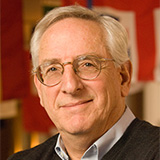
Norman M. Naimark is the Robert and Florence McDonnell Professor of East European Studies, a senior fellow of Stanford's Freeman-Spogli Institute, and a senior fellow at the Hoover Institution at Stanford University. Naimark is the author of numerous works of history, including the critically acclaimed volumes The Russians in Germany: The History of the Soviet Zone of Occupation, 1945–1949 (Harvard University Press, 1995), Fires of Hatred: Ethnic Cleansing In 20th Century Europe (Harvard University Press, 2001), Stalin's Genocides (Princeton University Press, 2010), and Genocide: A World History (Oxford University Press, 2016). His most recent book is Stalin and the Fate of Europe The Postwar Struggle for Sovereignty (Harvard University Press, 2019).

Bertrand M. Patenaude is a research fellow at the Hoover Institution Library & Archives and a lecturer at Stanford University. His first book, The Big Show in Bololand: The American Relief Expedition to Soviet Russia in the Famine of 1921 (Stanford University Press, 2002) won the 2003 Marshall Shulman Book Prize and was made into a documentary film for the PBS history series American Experience. He is also the author of Trotsky: Downfall of a Revolutionary (HarperCollins, 2009) and A Wealth of Ideas: Revelations from the Hoover Institution Archives (Stanford University Press, 2006).

Amir Weiner is associate professor of history, director of Graduate Studies, and director of the Center for Russian, East European and Eurasian Studies (CREEES) at Stanford University. His research interests include mass violence, population politics, totalitarianism, and World War II. He is the author of Making Sense of War: The Second World War and the Fate of the Bolshevik Revolution (Princeton University Press 2002), Landscaping the Human Garden: Twentieth-Century Population Management in a Comparative Framework (Stanford University Press, 2003), and the forthcoming At Home with the KGB: A History of the Soviet Security Service (Yale University Press, 2023).

Jovana Lazić Knežević is Associate Director of the Center for Russian, East European and Eurasian Studies (CREEES). Her historical research and teaching interests focus on belligerent occupation and the social and cultural history of the First World War; urban history; and the Habsburg Empire, the Balkans and Yugoslavia. She is the author of several book chapters and articles on gender and war and the Habsburg-occupied Serbian capital of Belgrade during World War I. A graduate of the Edmund A. Walsh School of Foreign Service at Georgetown University and recipient of a diplome from Sciences Po-Paris, she received her PhD from Yale University.
ABOUT THIS SERIES
The Bread + Medicine Speaker Series highlights conversations with historians of Russia and Ukraine and leading experts on famine and humanitarianism. It is presented in conjunction with the exhibition Bread + Medicine: Saving Lives in a Time of Famine devoted to the American famine relief mission to Soviet Russia in 1921–1923.



